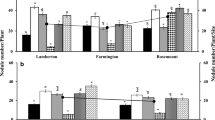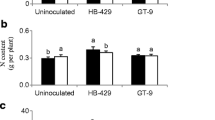Abstract
Common bean (Phaseolus vulgaris L.) crops hold the potential to obtain higher yields by enhancing their biological nitrogen fixation (BNF) with Rhizobium. However in contrast to other legumes, common bean has shown a lack of positive response to inoculation with Rhizobium in many cases. This has led to a limited use of rhizobial inoculants in this crop, especially in Europe. The adaptation of bacterial strains to the rhizosphere is a key factor in the success of any inoculant, especially in a promiscuous legume such as common bean. This research aimed at increasing common bean yields via inoculation with effective indigenous Rhizobium leguminosarum strains. Three highly effective strains (LCS0306, LBM1123 and ZBM1008) which were selected according to their effectiveness at BNF in hydroponic conditions were separately inoculated onto common bean in a field experiment. The experiment was carried out under three environments and three tillage systems: conventional-tillage (CONVT), no-tillage (NT) and a cover-crop (CC). The grain yield observed with seed inoculation was significantly higher than the yield obtained with uninoculated seed under CONVT and CC. However, under NT inoculation had no effect. Furthermore, under CONVT and CC, inoculation with R. leguminosarum LCS0306 produced even higher yields than those obtained in nitrogen-fertilised or control plots. This is the first attempt to explain the inoculation performance of common bean under different tillage systems in Europe. A gene–based hypothesis has been used to explain the effectiveness of indigenous common bean rhizobia as nitrogen fixers in this crop.


Similar content being viewed by others
References
Abdalla M, Osborne B, Lanigan G, Forristal D, Williams M, Smith P, Jones MB (2013) Conservation tillage systems: a review of its consequences for greenhouse gas emissions. Soil Use Manag 29:199–209. doi:10.1111/sum.12030
Aguilar OM, Riva O, Peltzer E (2004) Analysis of Rhizobium etli and of its symbiosis with wild Phaseolus vulgaris supports coevolution in centers of host diversification. Proc Natl Acad Sci U S A 101:13548–13553. doi:10.1073/pnas.0405321101
Albareda M, Rodríguez-Navarro DN, Camacho M, Temprano FJ (2008) Alternatives to peat as a carrier for rhizobia inoculants: solid and liquid formulations. Soil Biol Biochem 40:2771–2779. doi:10.1016/j.soilbio.2008.07.021
Alguacil MM, Roldan A, Salinas-Garcia JR, Querejeta JI (2011) No tillage affects the phosphorus status, isotopic composition and crop yield of Phaseolus vulgaris in a rain-fed farming system. J Sci Food Agric 91:28–272. doi:10.1002/jsfa.4180
Amarger N, Macheret V, Laguerre G (1997) Rhizobium gallicum sp. nov. and rhizobium giardinii sp. nov., from Phaseolus vulgaris nodules. Int J Syst Bacteriol 47:996–1006. doi:10.1099/00207713-47-4-996
Batish DR, Lavanya K, Singh HP, Kohli RK (2007) Phenolic allelochemicals released by chenopodium murale affect the growth, nodulation and macromolecule content in chickpea and pea. Plant Growth Regul 51:119–128. doi:10.1007/s10725-006-9153-z
Bizarro MJ, Giongo A, Kayser L, et al. (2011) Genetic variability of soybean bradyrhizobia populations under different soil managements. Biol Fertil Soils 47:357–362. doi:10.1007/s00374-010-0512-6
Buttery BR, Park SJ, Findlay WJ (1987) Growth and yield of white bean (Phaseolus vulgaris L.) in response to nitrogen, phosphorus and potassium fertilizer and to inoculation with rhizobium. Can J Plant Sci 67:425–432. doi:10.4141/cjps87-061
Cunningham MH, Chaney K, Bradbury RB, Wilcox A (2004) Non-inversion tillage and farmland birds: a review with special reference to UK and Europe. Ibis 146:192–202. doi:10.1111/j.1474-919X.2004.00354.x
Daza A, Santamaría C, Rodríguez-Navarro DN, Camacho M, Orive R, Temprano FJ (2000) Perlite as carrier for bacterial inoculants. Soil Biol Biochem 32:567–572. doi:10.1016/S0038-0717(99)00185-6
FAOSTAT (2015) FAOSTAT Agriculture Data. Food and Agricultural Organisation, Rome. http://faostat.fao.org. Accessed 23 April 2015
García-Fraile P, Mulas-García D, Peix A, Rivas R, González-Andrés F, Velázquez E (2010) Phaseolus vulgaris is nodulated in northern Spain by rhizobium leguminosarum strains harboring two nodC alleles present in American Rhizobium etli strains: biogeographical and evolutionary implications. Can J Microbiol 56:657–666. doi:10.1139/W10-048
Gepts P, Debouck D (1991) Origin, domestication, and evolution of the common bean (Phaseolus vulgaris L.). In: van Schoonhoven A, Voysest O (eds) Common beans: research for crop improvement. CAB, Wallingford, pp. 7–53
Graham PH (1981) Some problems of nodulation and symbiotic nitrogen fixation in Phaseolus vulgaris L.: a review. Field Crop Res 4:93–112. doi:10.1016/0378-4290(81)90060-5
Howieson J, Malden J, Yates RJ, O’Hara GW (2000) Techniques for the selection and development of elite inoculant strains of rhizobium leguminosarum in southern Australia. Symbiosis 28:33–48
Hughes RM, Herridge DF (1989) Effect of tillage on yield, nodulation and nitrogen fixation of soybean in far north-coastal New South Wales. Aus J Exp Agric 29:671–677. doi:10.1071/EA9890671
Hungria M, Loureiro MF, Mendes LC, Campo RJ, Graham PH (2005) Inoculant preparation, production and application. In: Werner D, Newton WE (eds) Nitrogen fixation in agriculture, forestry, ecology, and the environment. Springer, Dordretch, pp. 223–253
Hungria M, Vargas MAT (2000) Environmental factors affecting N2 fixation in grain legumes in the tropics, with an emphasis on Brazil. Field Crop Res 65:151–164. doi:10.1016/S0378-4290(99)00084-2
Inderjit LA, Weston B, Dukec SO (2005) Challenges, achievements and opportunities in allelopathy. J Plant Intearct 1:69–81. doi:10.1080/17429140600622535
Jiao YS, Yan H, Ji ZJ, Liu YH, Sui XH, Wang ET, Guo BL, Chen WX, Chen WF (2015) Rhizobium sophorae sp. nov. and rhizobium sophoriradicis sp. nov., nitrogen-fixing rhizobial symbionts of the medicinal legume sophora flavescens. Int J Syst Evol Microbiol 65:497–503. doi:10.1099/ijs.0.068916-0
Josephson KL, Bourque DP, Bliss FA, Pepper IL (1991) Competitiveness of KIM-5 and VIKING-1 bean rhizobia - strain by cultivar interactions. Soil Biol Biochem 23:249–253. doi:10.1016/0038-0717(91)90060-W
Kaschuk G, Hungria M, Andrade DS, Campo RJ (2006a) Genetic diversity of rhizobia associated with common bean (Phaseolus vulgaris L.) grown under no-tillage and conventional systems in southern Brazil. Appl Soil Ecol 32:210–220. doi:10.1016/j.apsoil.2005.06.008
Kaschuk G, Hungria M, Santos JCP, et al. (2006b) Differences in common bean rhizobial populations associated with soil tillage management in southern Brazil. Soil Tillage Res 87:205–2017. doi:10.1016/j.still.2005.03.008
Keller B, Baggiolini A (1954) Les stades repères dans la vegetation du blé, d’après l’échelle élaborée par freekes. Revue Romande Agriculture et Arboriculture 10:17–20
Kimura M (1980) A simple method for estimating evolutionary rates of base substitutions through comparative studies of nucleotide sequences. J Mol Evol 16:111–120. doi:10.1007/BF01731581
Liu Y, Wu L, Baddeley JA, Watson CA (2010) Models of biological nitrogen fixation of legumes. A review. Agron Sustain Dev 31:155–172. doi:10.1051/agro/2010008
Loureiro MF, Kaschuk G, Alberton O, et al. (2007) Soybean [Glycine max (L.) Merrill] rhizobial diversity in Brazilian oxisols under various soil, cropping, and inoculation managements. Biol Fertil Soils 43:665–674. doi:10.1007/s00374-006-0146-x
Mostasso L, Mostasso FL, Dias BG, Vargas MAT, Hungria M (2002) Selection of bean (Phaseolus vulgaris L.) rhizobial strains for the Brazilian cerrados. Field Crop Res 73:121–132. doi:10.1016/S0378-4290(01)00186-1
Mulas D, García-Fraile P, Carro L, Ramírez-Bahena MH, Casquero P, Velázquez E, González-Andrés F (2011) Distribution and efficiency of rhizobium leguminosarum strains nodulating Phaseolus vulgaris in northern Spanish soils: selection of native strains that replace conventional N fertilization. Soil Biol Biochem 43:2283–2293. doi:10.1016/j.soilbio.2011.07.018
Mulas D, Ramírez-Baena MH, García-Fraile P, Velázquez E, González-Andrés F (2008) Rhizobium leguminosarum is the predominant species found among rhizobia nodulating common bean (Phaseolus vulgaris L.) in León (Spain). 8th European Nitrogen Fixation Conference Gent (Belgium), pp 106
Oliveira JP, Galli-Terasawa LV, Enke CG, Cordeiro VK, Tavares Armstrong LC, Hungria M (2011) Genetic diversity of rhizobia in a Brazilian oxisol nodulating Mesoamerican and Andean genotypes of common bean (Phaseolus vulgaris L.). World J Microbiol Biotechnol 27:643–650. doi:10.1007/s11274-010-0501-9
Peix A, Ramírez-Bahena MH, Velázquez E, Bedmar EJ (2015) Bacterial associations with legumes. Crit Rev Plant Sci 34:17–42
Rigaud J, Puppo A (1975) Indole-3-acetic acid catabolism by soybean bacterioids. J Gen Microbiol 88:223–228. doi:10.1099/00221287-88-2-223
Rodríguez-Navarro DN, Buendía AM, Camacho M, Lucas MM, Santamaría C (2000) Characterization of rhizobium spp. bean isolates from south-west Spain. Soil Biol Biochem 32:1601–1613. doi:10.1016/S0038-0717(00)00074-2
Rogel MA, Ormeño-Orrillo E, Martinez-Romero E (2011) Symbiovars in rhizobia reflect bacterial adaptation to legumes. Syst Appl Microbiol 34:96–104. doi:10.1016/j.syapm.2010.11.015
Rubio Pérez LM (1987) La bañeza y su Tierra, 1650–1850. Un modelo de sociedad rural leonesa. Universidad de León, León, Spain
Ruffo ML, Bullock DG, Bollero GA (2004) Soybean yield as affected by biomass and N uptake of cereal rye in winter cover crop rotations. Agron J 96:800–805. doi:10.2134/agronj2004.0800
Saïdi S, Ramírez-Bahena MH, Santillana N, Zúñiga D, Álvarez-Martínez E, Peix A, Mhamdi R, Velázquez E (2014) Rhizobium laguerreae sp. nov. nodulates vicia faba on several continents. Int J Syst Evol Microbiol 64:242–247. doi:10.1099/ijs.0.052191-0
Saitou N, Nei M (1987) A neighbour-joining method: a new method for reconstructing phylogenetics trees. Mol Biol Evol 44:406–425
Santalla M, Rodiño AP, De Ron AM (2002) Allozyme evidence supporting southwestern Europe as a secondary center of genetic diversity for common bean. Theor Appl Genet 104:934–944. doi:10.1007/s00122-001-0844-6
Sombrero A, De Benito A (2010) Carbon accumulation in soil. Ten-year study of conservation tillage and crop rotation in a semi-arid area of castile-Leon, Spain. Soil Tillage Res 107:64–70. doi:10.1016/j.still.2010.02.009
Sturz AV, Christie BR (2003) Beneficial microbial allelopathies in the root zone: the management of soil quality and plant disease with rhizobacteria. Soil Tillage Res 72:107–123. doi:10.1016/S0167-1987(03)00082-5
Tamura K, Dudley J, Nei M, Kumar S (2007) MEGA4: molecular evolutionary genetics analysis (MEGA) software version 4.0. Mol Biol Evol 24:1596–1599. doi:10.1093/molbev/msm092
Thompson JD, Gibson TJ, Plewniak F, Jeanmougin F, Higgins DG (1997) The clustalX windows interface: flexible strategies for multiple sequence alignement aided by quality analysis tools. Nucleic Acids Res 24:4876–4882
Urbano B, González-Andrés F, Ballesteros A (2006) Allelopathic potential of cover crops to control weeds in barley. Allelopath J 17:53–64
Urchei MA, Rodrigues JD, Stone LF (2000) Growth analysis of two bean cultivars under irrigation in no tillage and the conventional tillage. Pes Agrop Bras 35:497–506. doi:10.1590/S0100-204X2000000300004
Vincent JM (1970) The cultivation, isolation and maintenance of rhizobia. In: Vincent JM (ed) A manual for the practical study of root-nodule. Blackwell, Oxford, pp. 1–13
Wang F, Wang ET, Wu LJ, Sui XH, Li Jr Y, Chen WX (2011) Rhizobium vallis sp. nov., isolated from nodules of three leguminous species. Int J Syst Evol Microbiol 61:2582–2588. doi:10.1099/ijs.0.026484-0
Wheatley DM, Macleod DA, Jessop RS (1995) Influence of tillage treatments on N2 fixation of soybean. Soil Biol Biochem 27:571–574. doi:10.1016/0038-0717(95)98633-Y
Acknowledgments
This research was supported by the Regional Government of Castile and Leon, project LE002B05. The Spanish Ministry of Education granted Daniel Mulas.
Author information
Authors and Affiliations
Corresponding author
Rights and permissions
About this article
Cite this article
Mulas, D., Seco, V., Casquero, P.A. et al. Inoculation with indigenous rhizobium strains increases yields of common bean (Phaseolus vulgaris L.) in northern Spain, although its efficiency is affected by the tillage system. Symbiosis 67, 113–124 (2015). https://doi.org/10.1007/s13199-015-0359-6
Received:
Accepted:
Published:
Issue Date:
DOI: https://doi.org/10.1007/s13199-015-0359-6




